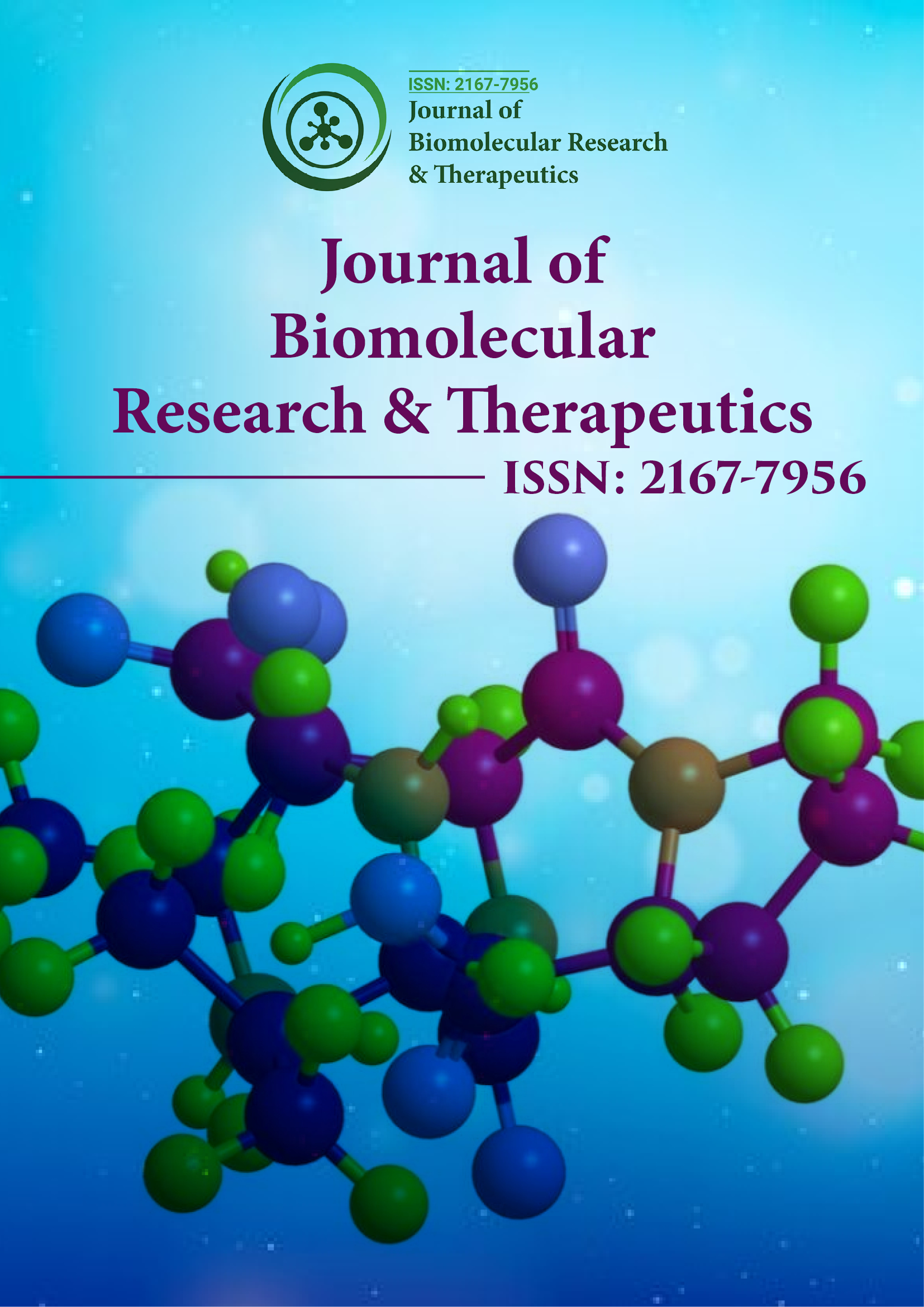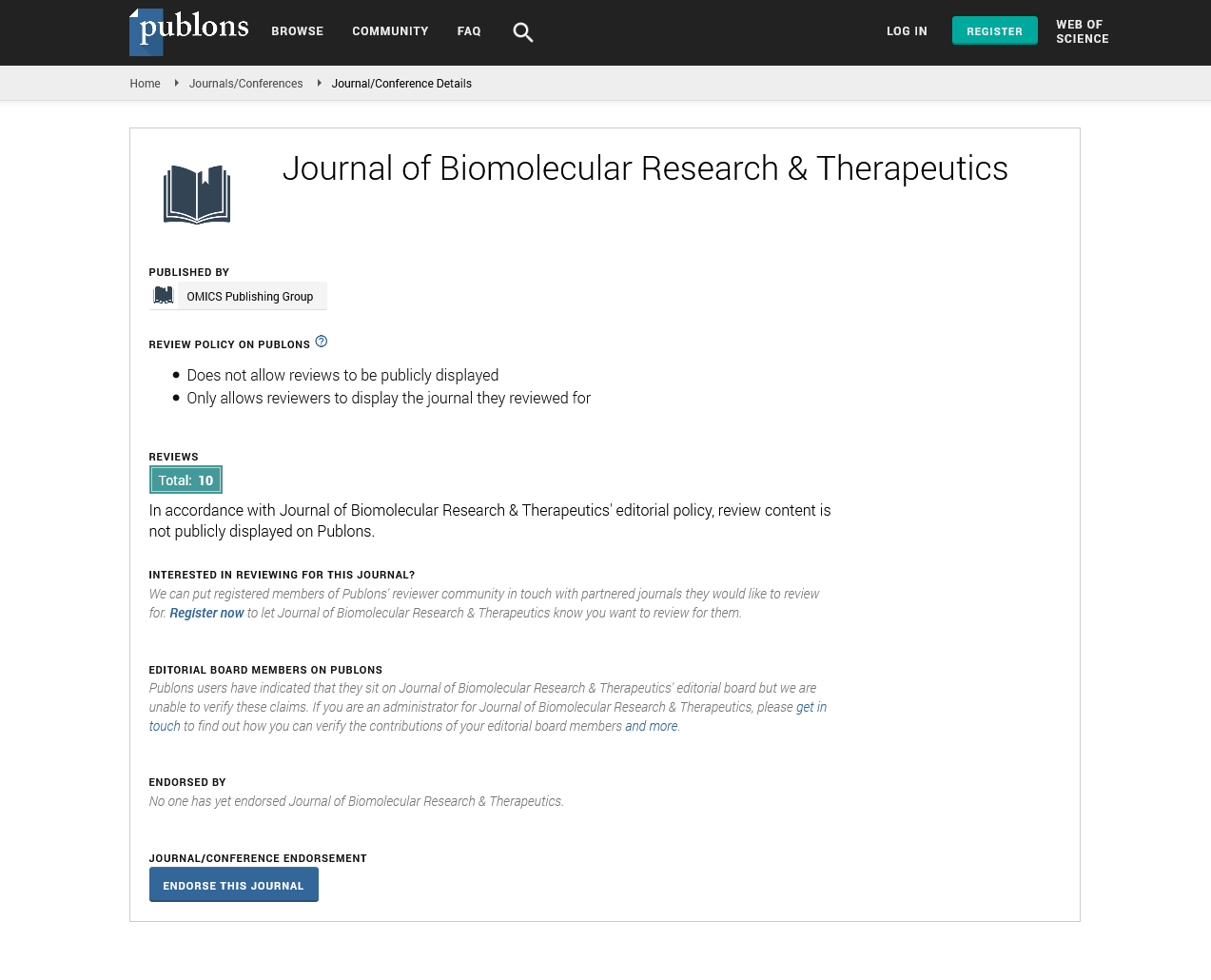Indexed In
- Open J Gate
- Genamics JournalSeek
- ResearchBible
- Electronic Journals Library
- RefSeek
- Hamdard University
- EBSCO A-Z
- OCLC- WorldCat
- SWB online catalog
- Virtual Library of Biology (vifabio)
- Publons
- Euro Pub
- Google Scholar
Useful Links
Share This Page
Journal Flyer

Open Access Journals
- Agri and Aquaculture
- Biochemistry
- Bioinformatics & Systems Biology
- Business & Management
- Chemistry
- Clinical Sciences
- Engineering
- Food & Nutrition
- General Science
- Genetics & Molecular Biology
- Immunology & Microbiology
- Medical Sciences
- Neuroscience & Psychology
- Nursing & Health Care
- Pharmaceutical Sciences
Opinion Article - (2025) Volume 14, Issue 1
Targeting the Wnt/β Catenin Pathway with Lipid Nanoparticles Encapsulating siRNA in Colorectal Cancer Models
Aylin Demir*Received: 27-Jan-2025, Manuscript No. BOM-25-29385; Editor assigned: 29-Jan-2025, Pre QC No. BOM-25-29385; Reviewed: 12-Feb-2025, QC No. BOM-25-29385; Revised: 18-Feb-2025, Manuscript No. BOM-25-29385; Published: 26-Feb-2025, DOI: 10.35248/2167-7956.25.14.423
Description
Colorectal Cancer (CRC) remains one of the leading causes of cancer-related mortality worldwide, with a complex molecular etiology that often involves aberrant activation of signaling pathways crucial for cell proliferation, survival and metastasis. Among these, the Wnt/β-catenin signaling pathway has been extensively implicated in the initiation and progression of colorectal tumors. Mutations in components such as APC (adenomatous polyposis coli) or β - catenin (CTNNB1) result in the constitutive activation of the Wnt pathway, leading to unchecked cellular growth and resistance to apoptosis. Given its central role in CRC pathogenesis and tumor maintenance, targeting the Wnt/ β - catenin pathway represents a compelling therapeutic strategy. However, traditional small-molecule inhibitors have shown limited clinical success due to challenges in specificity, bioavailability and toxicity. In recent years, RNA interference (RNAi) has emerged as a promising tool for genespecific silencing and when coupled with advanced delivery platforms like Lipid Nanoparticles (LNPs), siRNA therapeutics offer a new frontier in precision oncology.
This study investigates the design, development and therapeutic potential of lipid nanoparticle-encapsulated small interfering RNA (siRNA) specifically targeting β-catenin in preclinical colorectal cancer models. The goal was to disrupt oncogenic Wnt/β-catenin signaling at the post-transcriptional level, thereby reducing tumor cell viability and progression. Our approach involved the synthesis of chemically modified siRNAs designed to silence CTNNB1 mRNA, formulated into LNPs optimized for stability, biocompatibility and tumor-targeted delivery. These LNPs were engineered using ionizable lipids, cholesterol, helper phospholipids and Polyethylene Glycol (PEG)-lipid conjugates to enhance systemic circulation time and promote cellular uptake through endocytosis.
The resulting siRNA-LNP formulations were approximately 80-100 nm in diameter, with a near-neutral surface charge and high encapsulation efficiency (>90%), as confirmed by dynamic light scattering (DLS), Transmission Electron Microscopy (TEM) and gel electrophoresis assays. Stability studies indicated that the nanoparticles remained intact under physiological conditions and protected siRNA from serum nuclease degradation. In vitro screening was first performed on human CRC cell lines including HCT116, SW480 and DLD-1, all of which exhibit Wnt pathway hyperactivation. Treatment with β - catenin siRNALNPs resulted in a significant knockdown of CTNNB1 mRNA and protein expression, measured by qRT-PCR and Western blotting, respectively.
Functionally, silencing β - catenin induced marked antiproliferative effects, including reduced cell viability, G1-phase cell cycle arrest and enhanced apoptosis, as evidenced by increased caspase-3 activity and Annexin V staining. Downstream Wnt target genes such as c-MYC, cyclin D1 and AXIN2 were also significantly downregulated following treatment, indicating effective pathway suppression. Importantly, the cytotoxicity of the LNP formulation was minimal in non-tumorigenic colon epithelial cells (CCD841), highlighting the specificity of the therapeutic effect in malignant cells. These in vitro findings demonstrated the ability of β - catenin-targeted siRNA delivered via LNPs to functionally disrupt Wnt-driven oncogenic processes in CRC.
The in vivo efficacy of the siRNA-LNP therapy was evaluated using xenograft and orthotopic mouse models of colorectal cancer. HCT116-luciferase cells were injected subcutaneously or orthotopically into immunodeficient mice and treatment was initiated once tumors were established. Mice received intravenous injections of siRNA-LNPs twice weekly for four weeks. Tumor growth was monitored using bioluminescence imaging and caliper measurements. Compared to controls (scrambled siRNA-LNPs and saline), mice treated with β-catenin siRNA-LNPs exhibited a significant reduction in tumor size and bioluminescent signal intensity. End-point tumor analysis revealed diminished β - catenin expression, decreased Ki-67 proliferation index and increased cleaved caspase-3 staining, consistent with in vivo pathway inhibition and tumor regression.
Pharmacokinetic and biodistribution studies using fluorescently labeled LNPs confirmed efficient delivery to tumor tissues with minimal accumulation in off-target organs such as the liver and kidney. The LNPs exhibited a favorable circulation half-life (6 hours) and were well tolerated, with no observable signs of systemic toxicity or weight loss in treated animals. Serum liver enzyme levels and histopathological examination of major organs supported the safety profile of the formulation. These results collectively underscore the potential of LNP-mediated siRNA delivery as a systemic therapy for CRC.
One of the critical challenges in siRNA therapeutics is tumor specificity and endosomal escape. Our LNPs were designed with ionizable lipids that become positively charged at the acidic pH of endosomes, facilitating membrane destabilization and siRNA release into the cytosol. Moreover, passive targeting through the Enhanced Permeability and Retention (EPR) effect was complemented by PEG-lipid optimization to avoid rapid clearance by the mononuclear phagocyte system. These engineering strategies improved both efficacy and safety, enabling successful RNAi-based modulation of a historically “undruggable” target.
In conclusion, our findings demonstrate that targeting the Wnt/ β-catenin pathway with lipid nanoparticle-encapsulated siRNA is a feasible and effective therapeutic strategy for colorectal cancer. The siRNA-LNP approach offers high target specificity, low offtarget toxicity and strong antitumor efficacy in both in vitro and in vivo models. As the field of nanomedicine advances, such RNAi-based therapies may become integral components of personalized treatment regimens, particularly for cancers driven by dysregulated transcription factors and signaling pathways that are not amenable to conventional drugs. Future directions will include evaluating combination regimens with chemotherapy or immune checkpoint inhibitors, investigating efficacy in Patient- Derived Xenografts (PDX) and advancing toward clinical translation with GMP-grade siRNA and scalable nanoparticle production.
Citation: Demir A (2025 Targeting the Wnt/? Catenin Pathway with Lipid Nanoparticles Encapsulating siRNA in Colorectal Cancer Models. J Biol Res Ther. 14:423.
Copyright: © 2025 Demir A. This is an open access article distributed under the terms of the Creative Commons Attribution License, which permits unrestricted use, distribution AND reproduction in any medium, provided the original author and source are credited.

